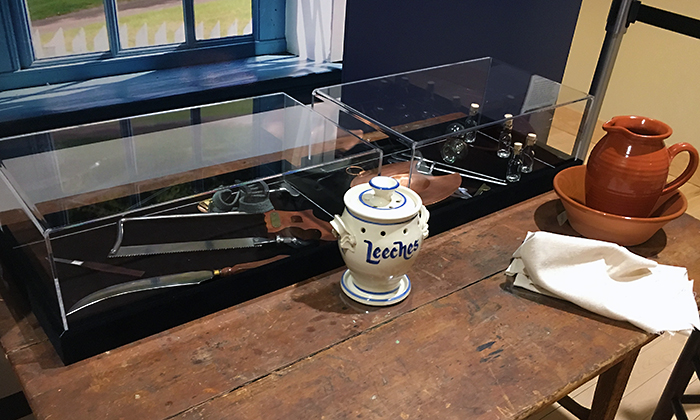
Though the world is currently buzzing with talk of symptoms, infection rates, and incubation periods, sickness and disease are fundamental pieces of human history. The time of General George Washington’s crossing of the Delaware River is no exception.
Sadly, more soldiers died from illness and disease than on the battlefield during the Revolutionary War. In fact, the graves behind the Thompson-Neely House are those of soldiers who died of illness during encampment, including Captain Lieutenant James Moore. In the words of Alexander Hamilton, Moore “died the 25th of December, after a short but excruciating fit of illness.”
No matter the illness, sick soldiers who were unable to perform their duties created a problem for any army set to do battle. Widespread illness could hinder their movement as well as their strategies. Ill soldiers also required resources to restore their health. This job typically fell to some of the camp followers or hired civilians. They weren’t trained nurses but were tasked with caring for the needs of the sick by changing linens, performing housekeeping duties and emptying chamber pots.
In addition to illness running through the camps, officers often stayed in private homes in the area, thus potentially introducing diseases that hadn’t been in the community before.
Smallpox and Early Vaccinations
Smallpox was rampant in the colonial era and killed millions before inoculation became common in the mid-18th century. The disease, which has a 10-14 day incubation period, included symptoms like fever, headache, severe fatigue, and back pain. Small red spots would appear on the skin and turn into fluid-filled blisters which eventually became pus. Once the lesions dried up and fell off, deep-pitted scars were often left on the skin.
George Washington had smallpox as a young man and had a basic understanding of immunity. During the 1775 British occupation of Boston, the city had a smallpox epidemic. To prevent the spread of the disease to American soldiers, Washington forbade the entry of Boston residents fleeing the occupation into Continental Army encampment sites. After the British evacuated, Washington sent only soldiers already immune to the disease to guard the city.
In January 1777, following Washington’s crossing of the Delaware River and victories at Trenton and Princeton, large-scale inoculations were ordered for the Continental Army.
This was a huge risk. The procedure—called variolation after variola, the virus that causes smallpox—was relatively new and frightening to many. A physician would make an incision in the patient and place a bit of smallpox infection in the wound. The patient would then develop a mild case of smallpox and become immune once they recovered.
Complicating matters even further, many governing bodies feared the practice.
Nevertheless, Washington took the gamble—and the risk paid off. The army developed immunity to smallpox and defeated British forces who actually had more exposure to smallpox over the years and a higher population of survivors with immunity.
Typhus and Dysentery in Bucks County
While smallpox outbreaks had a large impact throughout the Revolutionary War, there wasn’t an outbreak during Washington’s time in Bucks County. For the few weeks that he and his army were in the area, the bigger threat was camp fever, which is believed to be typhus.
Typhus is a deadly bacterial infection transmitted by fleas, ticks and lice. It was known to spread rapidly throughout the overcrowded, unhygienic army camps. Early symptoms of typhus are similar to those of other illnesses, including fever, headache, body aches, cough and diarrhea.
Dysentery was also a problem in army camps during this time. Early in the war, Continental Army encampments weren’t yet up to the standards of European armies. For instance, the latrines were often too close to the camp itself
It wasn’t until 1778 at Valley Forge when Baron von Steuben, a Major General in the Continental Army, took on the task of establishing standards for camp sanitation and established criteria for camp layout that lasted into the next century.
Colonial-Era Illness Up Close
To learn more about illness and medicine during the Revolutionary War, be sure to visit Washington’s Crossing Historic Park Visitor Center—once Washington Crossing Historic Park fully reopens to the public, of course.
In the “Soldier Health in Revolutionary Pennsylvania” exhibit, visitors can step into a sick room that recreates the spaces that soldiers recuperated in during the Continental Army’s 1776 encampment at the Thompson-Neely House. The exhibit also displays medical tools that doctors would have used to treat patients.

